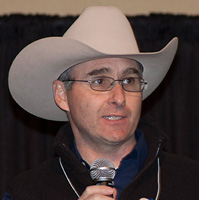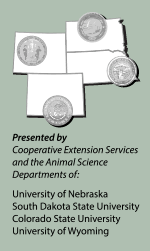Operation Growth
Makes Room for More
Make the pie bigger to involve the whole family rather than divide the pie.
by Kasey Brown, associate editor, Angus Journal
RAPID CITY, S.D. (Dec. 4, 2013) — Family operations are a different animal, Don Schiefelbein, Schiefelbein Farms, Kimball, Minn., told attendees of the Range Beef Cow Symposium in Rapid City, S.D., Dec 4. Family operations are both family and business, and you can’t just love each other enough to make the business work, he emphasized.

Don Schiefelbein
With nine brothers and parents still involved in Schiefelbein Farms, the operation has grown quite a bit. Each family member is responsible for a key area of the business, he explained.
There are two ugly things about a family business that no one likes to talk about, but that do matter — money and power. With everyone’s specialties, he said that the group is the boss, which means that the group has a chance to veto certain decisions, but lets everyone take care of their area without the pressure of having one boss.
With a large family, he emphasized that the pie needs to get bigger instead of trying to divide the pie evenly..
“Money doesn’t create happiness, but it sure can reduce stress,” he noted. In the 1980s, the message to the cow-calf producer was to be a low-cost producer. However, when they cut their costs as much as possible, the revenue was also much smaller. They decided to shift the paradigm that he likened to the movie Moneyball. Simply put, selecting on eyeball alone was not going to find the “next great one.” The whole picture must be used to improve quality.
Instead of cutting costs, they started increasing revenue, Schiefelbein explained. “Ignorance purchases on price. Knowledge purchases on value. You have to spend money to make money.”
As a seedstock producer, this means making every mating count. They artificially inseminate (AI) every heifer twice and every cow once. They have a rapid herd turnover to keep the most current genetics in the herd, and they use embryo transfer to put higher-value embryos in marginal cows.
They also spend more money to buy calves from their customers for their feedyard. By investing in their own genetics, they support their customers and end up making a premium because they use their genetics to reach Certified Angus Beef® (CAB®) brand acceptance. All together, their customers make money, Schiefelbein Farms makes money, and the packers make money.
For the Schiefelbein Farms, all profits are split evenly. He added that to make more money, the pie has to get bigger. “Don’t be a low-cost producer, be a high net-revenue producer,” he concluded.
Schiefelbein spoke Wednesday at RBCS XXIII. Visit the Newsroom at www.rangebeefcow.com/2013 to view his PowerPoint, read his proceedings paper or listen to his presentation.
---------------------
The RBCS is a biennial educational symposium offering practical production management information. It is sponsored by the Cooperative Extension Service and animal science departments of the University of Wyoming, South Dakota State University, Colorado State University and the University of Nebraska.
Comprehensive coverage of the symposium is available online at www.rangebeefcow.com. Compiled by the Angus Journal editorial team, the site is made possible through sponsorship of LiveAuctions.tv and the cooperation of the host committee.
Editor’s Note: This article was written under contract or by staff of the Angus Journal. To request reprint permission and guidelines, contact Shauna Rose Hermel, editor, at 816-383-5270.


